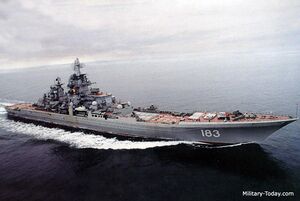City-Class Ultra-Heavy Cruiser
 LNS Akron (CH-02)
| |
| Class overview | |
|---|---|
| Builders: | Librira |
| Operators: |
|
| Preceded by: | Grekov-Class |
| Succeeded by: | none |
| Built: | 1975-1982 |
| In commission: | 1979-present |
| Planned: | 7 |
| Completed: | 3 |
| Cancelled: | 4 |
| Active: | 2 |
| Laid up: | 1 |
| General characteristics | |
| Type: | Ultra-Heavy Cruiser |
| Displacement: | 28,000 tons normal load |
| Length: | 253 m (830 ft) |
| Beam: | 29 m (95 ft) |
| Draft: | 9.5 m (31 ft) |
| Propulsion: | 2x R-2 Reactors |
| Speed: | 34 knots (63 km/h; 39 mph) |
| Range: | unlimited |
| Complement: | 700 including crew and troops |
| Sensors and processing systems: |
|
| Armament: |
1x 5 AA-25M ASW Rocket Launcher 6x 1 540mm Torpedo/missile launcher system |
| Aircraft carried: | 2 Helicopters |
The City-Class Ultra-Heavy Cruiser is a class of Ultra-Heavy Cruiser used by the Libriran Navy. The class is the first class of Ultra-Heavy Cruiser built, though it traces its lineage to Libriran battlecruiers. The class is named for large Libriran cities. The ships were developed as the capital ship companion for the smaller Zvesda-Class and Region-Class cruisers. they were ordered in 1975, with 7 originally planned. However, the cost of these large nuclear powered cruisers, meant that only 3 were completed before they were replaced by the largely similar, but conventional powered Hero-Class
Development
After the development of effective AShMs almost immediately it was put into use on virtually every ship that had the room. This created a shifting of ship roles, and classifications. Save for the Battlecruiser, because in Libriran designations a Battlecruiser was a 'Battleship-type armament on a lighter and fast hull intended to cooperate with cruiser forces and attack enemy battle groups and shipping'. Because there was no battleships converted to utilize guided missiles, the Libriran Navy Board created a new designation, the Ultra-Heavy Cruiser. Designed to preform a similar roles as battlecruisers, they are often called as such by other nations, however, within the Libriran navy the fill a similiar but distinct role, with a focus on ship-to-ship and other support operations.
Design
The City-Class was intended to be the most powerful surface ship ever deployed in the Libriran fleet. Design work began in 1965 on a Nuclear powered cruiser, originally as a cross between traditional battlecruisers and guided missile ships, it would have mounted 12in guns on the bow with its aft area being devoted to VLS tubes and other missiles armament. This idea was scrapped due the the weight, cost, and limited utility of such large guns in the modern era. The cruiser eventually developed into a flagship and director cruiser. With powerful radar and tracking equipment it was intended for the Ultra-Heavy cruiser to lead cruiser groups in the destruction of enemy surface groups.
The class originally was fitted with the M-700 AShM, which was the longest ranged AShM then developed giving the City-class un-matched reach and hitting power. in the early 2000s this was upgraded to the M-1000 a slightly smaller missile but with even greater potency. The missiles are loaded into VLS tubes laid into the deck forward of the main super-structure. This was a first at the time for a Libriran surface ship. It allows the ship to carry more missiles than its smaller counterparts, but at the cost of safety; if a missile engine fails after launch, it will come back down onto the deck of the ship.
one of the Hallmarks of the class is its nuclear power. Fitted with two R-2 reactors, each making around 300mW, is enough to power all the ships systems and propulsion allowing the ship, to have unlimited range and a top speed of nearly 35 knots. The reactor itself is an englarged development of the X series of reactors developed for submarine usage, it is a conventional pressurized water reactor.
the largest part of the ship is its two towers that house its radars. The City-Class was equipped with some of the most advanced radar available and a unique computer system that allows the City-class to network with other cruisers and missile in flight and share targetting data. This systems exact workings are top secret, but is a feature on all city-class, and has been upgraded in past refits. its expected to be upgraded to a newer version by 2025.
Ships in Class
| Pennant no. | Name | Laid down | Launched | Commissioned | Homeport | |||
|---|---|---|---|---|---|---|---|---|
| CH-01 | Viborn | 23 April 1975 | 15 March 1977 | 5 June 1979 | Foskva | |||
| CH-02 | Akron | 2 January 1976 | 6 August 1977 | 1 January 1980 | Harbraskaya | |||
| CH-03 | Kosporovo | 19 June 1977 | 6 October 1979 | 10 August 1981 | Laid up in Nieper | |||
| CH-04 | Nieper | 5 September 1980 | Cancelled 1 January 1982 | |||||
| CH-05 | Akria | 2 April 1980 | Cancelled 1 January 1982 | |||||
| CH-06 | Nardonyy Gorod | Cancelled 1 January 1982 | ||||||
| CH-07 | Nieransk | Cancelled 1 January 1982 | ||||||